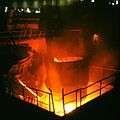Tatara (furnace)
.jpg)
The tatara (鑪) is the traditional Japanese furnace used for smelting iron and steel. The word later also came to mean the entire building housing the furnace.
The steel, or tamahagane (玉鋼), used in the forging of Japanese swords (nihontō (日本刀), commonly known as katana (刀)) by contemporary Japanese forge masters like Kihara Akira and Gassan Sadatoshi is still smelted in a tatara. One of the few remaining tatara is the Nittoho tatara in Shimane Prefecture, Japan.
Etymology
It is generally agreed that the word tatara is foreign to Japan, originating in India or Central Asia. There is a possibility that the word came from a place in ancient Korea, where the two dynasties would often meet. According to the Kojiki (one of the oldest Japanese historical texts), this meeting place was called Tatara-ba (たたら場) or Tatara-tsu (たたら津), and the word was possibly imported with iron-working technology. Japanese scholar Tokutaro Yasuda suggests that the word may be from the Sanskrit word tātala, meaning "heat," noting that the Hindi word for steel is sakeraa, which is very similar to the word kera (鉧) used in Japan for the steel bloom which the tatara produces.[1][2] The two Chinese characters used when the word has the original meaning are 踏鞴 and, besides as tatara, they can be also read as fumifuigo, or foot bellows.
Process
The smelting process used is different from that of the modern mass production of steel. A clay vessel about 1.1 meters (4 feet) tall, 3 meters (12 feet) long, and 1.1 meters (4 feet wide) is constructed. This is the tatara. After the clay tub has dried, it is fired until dry. A charcoal fire is started from soft pine charcoal, then the smelter will wait for the fire to reach the correct temperature. At that point, he will direct the addition of ironsand, known as satetsu. This will be layered in with more charcoal and more ironsand over the next 72 hours. 4 or 5 people need to constantly work on this process.
It takes about a week to build the tatara and complete the iron conversion to steel. When the process is done, the clay tub is broken and the steel bloom, known as a kera, is removed. At the end of the process, the tatara will have consumed about 10 tons of satetsu and 12 tons of charcoal, leaving about 2.5 tons of tamahagane.
The Nittoho Tatara
In 1977, the Japanese Society for Preservation of Japanese Art Swords (Nittoho), together with the Japanese government's Agency for Cultural Affairs and Hitachi Works, built in Shimane Prefecture the so-called Nittoho Tatara to provide the steel necessary for the production of Japanese swords. The Nittoho Tatara is managed jointly with Yasugi Works, a subsidiary company of Hitachi Metals, and is operational only during the winter.
See also
References
- ↑ http://www.hitachi-metals.co.jp/tatara/nnp0101.htm
- ↑ http://www.hitachi-metals.co.jp/e/tatara/nnp0101.htm
- Iwanami Kōjien (広辞苑) Japanese dictionary, 5th Edition (2000), CD version
- The Tale of the Tatara, Hitachi Metals, Ltd.
- The Nittoho Tatara in Shimane Prefecture, YouTube.
- thejapanesesword.com Tatara
- Masaru Fujimoto Weapons of Wonder, The Japan Times, March 16, 2003.
